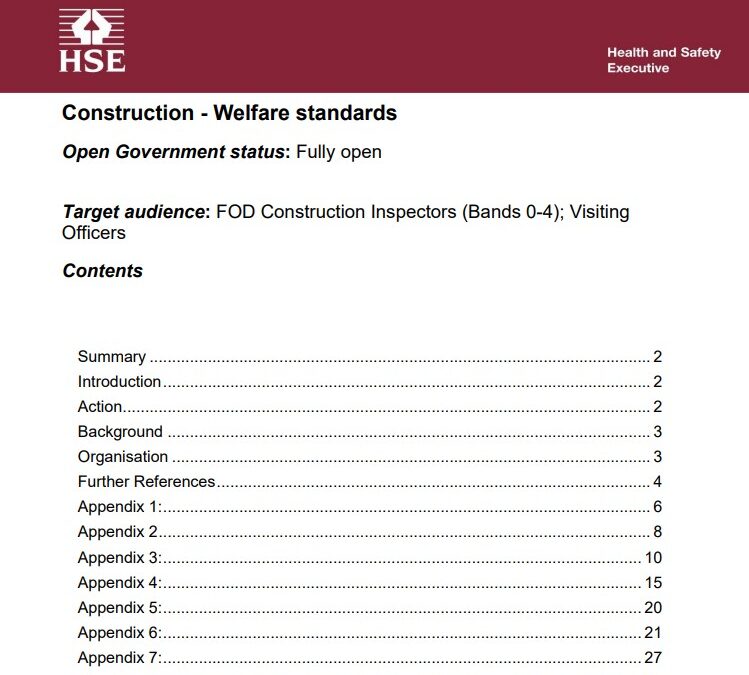In November 2022, HSE published internal operational guidance relating to the provision of welfare facilities on all UK construction sites. Internal operational guidance provides a resource for HSE Inspectors & Visting Officers to help form or support their opinion regarding the standards observed on site. It should also help influence and support enforcement decisions where standards fall below the benchmark. The big question though, is where exactly does that benchmark lie, and what does it mean for the Asbestos industry…?
Prior to this latest guidance release, it’s fair to say that HSE welfare expectations have increased over the years, for example the usage of a local café was once deemed sufficient for short duration/transient sites a decade ago, but this is certainly not true today. And as the not-for-profit trade association promoting best practice for the Asbestos removal industry, ACAD has consistently championed higher welfare standards with two main reasons behind this stance.
Firstly, best practice standards for welfare so often translate through to best practice standards for the whole site, which is at the heart of what ACAD & our members stand for.
And secondly, this is about ensuring Asbestos Industry workers, who we ask to deal with a category 1 carcinogen, often on less salubrious sites, alongside other hazards, and so often outside of the normal 9 ‘til 5 routine, have access to high quality welfare that helps remind them just how important their work is to us all.
This raising of expectations around welfare over the past decade helped drive the Licensed Asbestos industry to innovate, typically in the form of a combined Decontamination Unit (DCU)/Welfare trailer. For all HSE Licensed Asbestos removal sites, a fully functioning DCU is a standard requirement on site. By combining this essential decontamination unit with a toilet and welfare/rest area, those manufacturers have helped move the Asbestos removal industry towards compliance with these increasing expectations.
Looking at the requirements for the toilet more closely show more detail around the evolved expectations, with the biggest addition being the expected availability of sanitary bins which is an important and welcome shift as the Asbestos industry workforce continues to diversify.
Graham Warren commented “ACAD member ABP Associates for example, employ 7 female analysts from a team of 11, which is truly inspiring to see. And whilst they operate on the analytical side of the Asbestos Industry, there is nothing to stop the removal side following suit. ACAD’s recent member survey found almost all ACAD members are struggling to recruit, yet very few females currently work on the removal side of things, in fact it’s close to single figures from a workforce of thousands nationwide so there’s an obvious potential labour pool to encourage into the Asbestos removal industry”.
And whilst lots of focus has been on ensuring construction sites are suitable for females, we mustn’t lose site of the fact that we have an ageing & predominantly male workforce who stand to benefit from this measure too. Many of whom will have, or develop, health issues requiring the usage of sanitary disposal on site and will be unlikely to bring this issue to the attention of their employer themselves.
Combined DCU/Welfare units were designed to move the typically problem area of 1 day/short duration jobs towards compliance with the requirements of Schedule 2 from the CDM regs covering minimum welfare facilities required for construction sites, and also those from Construction Information Sheet (CIS) 59, which covers the provision of welfare facilities during construction work. Their introduction also meant only a single vehicular movement was needed to a particular site with the obvious environmental benefits that brings.
One disturbing exception to these requirements did appear via the FAAM conference in November 2021, where the Asbestos industry heard truly shocking revelations around female safety on site. This, in part, related to the lack of door locks, operable by the user from the inside of the DCU, making the DCU single occupancy. And whilst these wouldn’t guard against everything, the fitting of these as standard was suggested by the Female Analyst Working Group (FAWG) as a positive step in the right direction.
Graham Warren advised “The new guidance reinforces the requirement to have lockable areas for changing. But it also takes this a step further via a section on propriety which leads to an obvious conflict with how the industry currently operates, particularly where larger numbers of workers are required. Whilst everybody would agree that males and females aren’t expected to get changed together, the guidance explains how changing areas should ensure the occupier’s privacy, irrespective of a person’s gender”.
DCU’s can have 2 or even 4 shower heads fitted within a single space, with the number of showerheads required being calculated from a 1 to 4 ratio of shower heads to workers. But expecting multiple workers to shower together and get changed or dressed together appears contrary to this latest guidance.
The obvious solution that answers this, and the FAWG concerns, is to introduce single occupancy lockable DCUs for all. During the covid pandemic, the Asbestos Industry stepped up to the challenge and implemented social distancing which created these. But we’d likely need to see some updating of guidance around the 1:4 ratio to support this, combined with a simple staggering of shift patterns for larger sites.
Graham Warren went on to say “A further positive reason to implement single occupancy DCUs is to remove any possible peer pressure for an individual to rush their decontamination, particularly where they may not want to be seen naked within the shower area, with the obvious potential Asbestos issues. And even if colleagues aren’t rushing them, the fear will still be present. By having an internally lockable single use DCU, site operatives will not feel pressurised, both actual and perceived, to rush this critical safety step. And by embracing single occupancy lockable DCU’s, the industry will remove all potential barriers to employment based on gender or religion, supporting & encouraging diversity in the workforce, and creating a real route to help plug the skills shortage in construction”.
So where will the compliance line fall? Whilst many of the more detailed points within the new internal operational guidance are fairly simple to implement, including sanitary bins and toilet brushes, others will take time. HSE have engaged with all manufactures within the Asbestos industry to support their understanding of these evolving requirements, which is most welcome as we all work together to help raise standards. However, the more involved elements will take time to fully implement throughout the industry, as the current fleet is worked through. As such, this guidance, at least in part, seems to be about setting the direction of travel for the coming years, the best practice path, one that is supported, encouraged and championed by ACAD.





